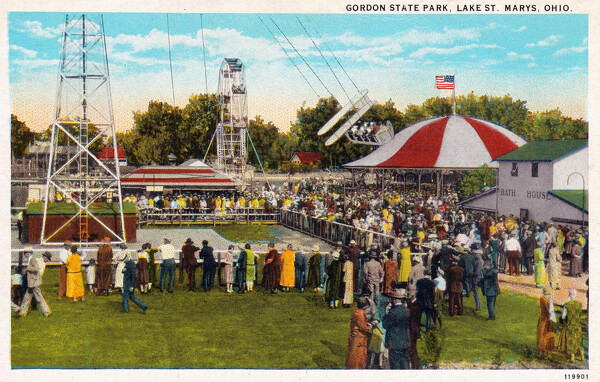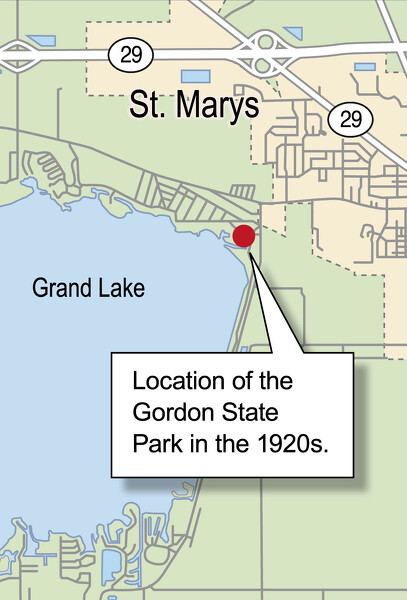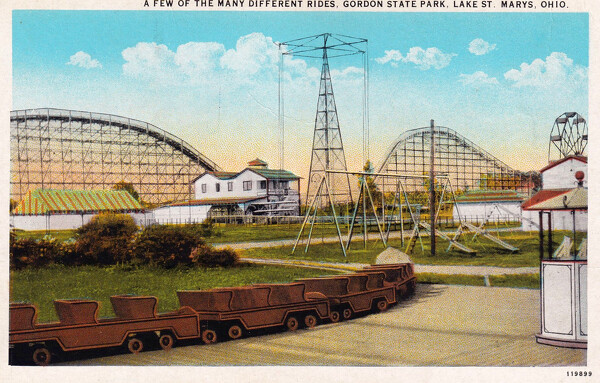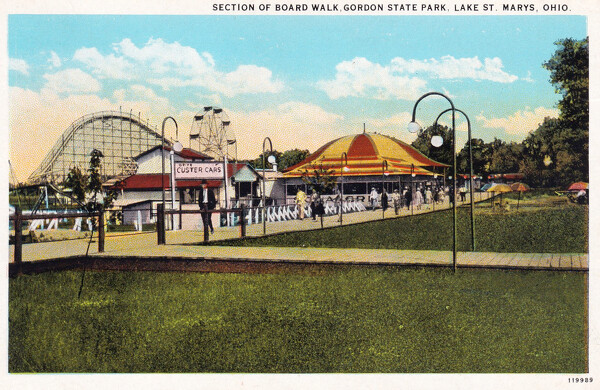
A few of the many different rides at the former Gordon State Park near St. Marys. Vintage postcards capture the charm and excitement of Gordon State Park.
CELINA - In the early 20th century, Gordon State Park drew revelers from far and near to the northeastern shoreline of Grand Lake with its thrilling rides, massive dance hall and other glitzy attractions.
The 13-acre amusement park built in 1924 near what is now the Villa Nova housing subdivision outside St. Marys operated for nine glorious years until the Depression and a string of calamities brought about its demise.
Denny Long, a retired teacher and football coach from St. Marys and a roller coaster aficionado who has ridden 668 coasters in over 200 amusement parks across the globe, captivated attendees at Lake Improvement Association's Saturday morning meeting with an engrossing presentation on the park's history.
Just over a century ago, Grand Lake was transitioning from a lucrative source of oil to a recreational hub, according to Long. Robert Gordon, the richest and most powerful person in St. Marys who owned several properties, businesses and a swath of land, saw an opportunity.
"He would take the high ground here at Village Nova, dividing it into building lots where people could come and build the cabins, summer cottages, and he'd sell the lots off and make a whole bunch of money," Long said, pointing to a map showing an area of land nestled between State Route 364 and Parkway Drive.
Standing in the way of his plan was a swamp, "right there in his front yard, right there at the entrance to Village Nova," Long said.

The former Gordon State Park was located near St. Marys in the 1920s.
Gordon also happened to be a U.S. congressman and a had many friends, among them Harold Neely, the St. Marys mayor at the time and son of oil tycoon Lemon Neely.
"Harold Neely and his dad Lemon Neely invented offshore drilling. Made a lot of money," Long said. "But, the oil wells petered out by 1924 and Harold was looking for a way to invest his money. He decided to make an amusement park. They were popular in the '20s."
Long said Gordon and Neely got together and hatched a scheme in which Gordon would donate 13 acres of his property to the state of Ohio, which would then turn around and lease the land to Neely on which to build an amusement park.
"So everyone's happy. Gordon is rid of a nuisance and an eyesore. Neely has a place for his amusement park. He's happy. The state of Ohio, I don't know if they knew what was going on," Long said.
Looking to mitigate the waves that came in all the way from Montezuma and splashed into the low lying area of land, feeding the swamp, Neely built a cement breakwater in the lake, which is still there today, and then a beach, now known as Sunset Beach.
He also crisscrossed the area with 12-foot-wide boardwalks, Long said.
On the beach Neely erected two giant slides each over 30 feet high, put up a parking lot between Parkway Drive and the unmarked Gordon Park Drive and constructed a dance hall.
"Big beautiful dance hall, it was almost twice as big as the state marina building that sits on that spot right now and it was three times as tall," Long said.
Attached to the dance hall was an inn that served up what it claimed to be "world famous pork sandwiches," Long pointed out.

A few of the many different rides at the former Gordon State Park near St. Marys. Vintage postcards capture the charm and excitement of Gordon State Park.
The crown jewel of the park, though, was the Devil's Backbone, then Ohio's second-largest rollercoaster. Long compared the wooden rollercoaster to the Blue Streak at Cedar Point in Sandusky.
It spanned 2,000 feet in length and had a top hill height of 75 feet. A St. Marys undertaker came up with the coaster's diabolical moniker, winning $25 in a naming contest, Long said.
"They advertised it 90 feet tall and 90 miles per hour. It wasn't anything near that. A lot of hype in those Days," he said.
Upon arriving in St. Marys in 1962, Long was fascinated by tales of Grand Lake's "Lost Amusement Park" and the Devil's Backbone rollercoaster in particular, which fueled his research into local history, according to LIA.
"Three big hills out, turn around, four little bunny hops coming back," he said of the roller coaster's features.
Thrill-seekers had to fork over 15 cents to take a ride on the Devil's Backbone and a nickel for each dance with the dance hall ladies.
"This is a time when bread cost 10 cents a loaf," Long noted.
Two riders - both drunk - in separate incidents actually came out of their seats on the roller coaster. One man fell off on the first hill but survived.
"The attending physician said that if he had been sober, the fall would have probably killed him. It was in the paper," Long said, pointing out this was during the Prohibition era.

The Old Mill and Devil's Backbone at the former Gordon State Park near St. Marys. Vintage postcards capture the charm and excitement of Gordon State Park.
There were several other rides at Gordon State Park - Custer Cars, a 60-foot ferris wheel, a merry-go-round, a little train, the Old Mill water ride/tunnel of love and a giant swing, Long said.
The Mary Jane was a barge that ferried up to 40 people at a time around Grand Lake.
Additional attractions came and went over the park's nine-year lifespan.
"Sometimes they had pony rides. For a time they had a funhouse. They had a circus act, jugglers, tightrope walkers. They had carnival acts, freak shows, two-headed cow, tattooed lady," Long pointed out.
According to "History of Gordon State Park" compiled by St. Marys historian George Neargarder, visitors who wanted a more leisurely visit could picnic at one of the three pavilions or relax under the brightly-colored canopy umbrellas that ran along the edges of the boardwalk.
Five or six permanent lunch stands were built throughout the park and were mostly owned by local people. A large athletic field provided for organized sports, such as baseball tournaments, foot races and horseshoe contests.

A section of boardwalk at the former Gordon State Park near St. Marys. Vintage postcards capture the charm and excitement of Gordon State Park.
On July 4 and 5, 1926, the park saw crowds reach 45,000, according to "History of Gordon State Park."
Despite its high popularity in the late 1920s, the start of the Great Depression in the early 30s forced increasing numbers of people to stay at home. The falling numbers, mingled with high operating expenses, threatened the life of the park.
Long said a fire burned the dance hall to the ground, gutted the restaurant and charred the Devil's Backbone. The next year, a tornado swept through, toppling the back part of the roller coaster and damaging the Old Mill water ride/tunnel of love.
"That was just too much. Neely thew up his hands. He quit. He was out of money," Long said. "Now that has a good ending. Neely went to Texas, Fort Worth area, got back in the oil business, something he knew about, made a lot of money and died a rich man."
However, Gordon State Park met a tragic end. The park was closed and liquidated, with the roller coaster sold for building materials, the boats from the water ride put up for sale, the boardwalk salvaged for "firewood at best."
"The Custer Cars were sold off," he said. "The Mary Jane tour boat sailed off into the sunset."
